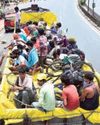The foundation laying work for reactor units three and four has begun and talks for units five and six are under way.

THE Kudankulam Nuclear Power Plant (KKNPP) site on 2,619 acres in Tirunelveli district, Tamil Nadu, is buzzing with construction activity and the mood is effervescent. The first Russian unit, called VVER-1000, has been generating its full power output of 1,000 MWe from February 22. The second unit, also a Russian VVER-1000, reached criticality on July 10 and was synchronised with the electricity grid on August 29. It is undergoing “phase C” checks, with its electricity output being raised in stages. It is expected to generate its full power of 1,000 MWe by the end of 2016.
On October 15, at Benaulim, Goa, Prime Minister Narendra Modi and President of the Russian Federation Vladimir Putin pressed a button to signal the start of the foundation concrete laying work for reactor units 3 and 4 of 1,000 MWe each. Simultaneously, at the Kudankulam site, S.K. Sharma, Chairman and Managing Director, Nuclear Power Corporation of India Limited (NPCIL), and Valery Limarenko, president, Atomstroyexport, waved green flags as concrete was poured into the foundation pits. The first pour of nuclear concrete, which signals the start of construction of the two units, is expected to take place in the first quarter of financial year 2017-18. The estimated cost of building Kudankulam 3 and 4 is Rs.39,849 crore. While Atom stroy export, the Russian state company, will supply the technology, the equipment, the components and the individual systems, NPCIL will build the reactors as was the case with Kudankulam 1 and 2.
This story is from the November 11, 2016 edition of FRONTLINE.
Start your 7-day Magzter GOLD free trial to access thousands of curated premium stories, and 9,000+ magazines and newspapers.
Already a subscriber ? Sign In
This story is from the November 11, 2016 edition of FRONTLINE.
Start your 7-day Magzter GOLD free trial to access thousands of curated premium stories, and 9,000+ magazines and newspapers.
Already a subscriber? Sign In

How Not To Handle An Epidemic
The lockdowns were meant to buy time to put in place appropriate health measures and contain the coronavirus’ spread, but they have failed to achieve the objective and heaped immense misery on the marginalised sections of society. India is still in the exponential phase of the COVID-19 infection and community transmission is a reality that the government refuses to accept.

Tragedy on foot
As the COVID-19-induced lockdown cuts the ground beneath their feet in Tamil Nadu, thousands of migrant workers are trudging along the highway to the relative safety of their upcountry homes.

Sarpanchs as game changers
Odisha manages to keep COVID-19 well under control because of the strong participation of panchayati raj institutions and the community at the grass-roots level under the leadership of Chief Minister Naveen Patnaik.

Scapegoating China
As the COVID-19 death rate spikes and the economy tanks in the United States, Donald Trump and his advisers target China and the World Health Organisation with an eye to winning the forthcoming presidential election.

New worries
Kerala’s measured approach to the pandemic and lockdown has yielded results. But it still has to grapple with their huge economic impact on its economy, which it feels the Centre’s special financial relief package does little to alleviate.
No love lost for labour
Taking advantage of the lockdown and the inability of workers to organise protests, many State governments introduce sweeping changes to labour laws to the detriment of workers on the pretext of reviving production and boosting the economy.

Capital's Malthusian moment
In a world that needs substantial reorienting of production and distribution, Indian capital is resorting to a militant form of moribund neoliberalism to overcome its current crisis. In this pursuit of profit, it is ready and willing to throw into mortal peril millions whom it adjudicates as not worth their means—an admixture of social Darwinism born of capital’s avarice and brutalism spawned by Hindutva. .

Understanding migration
When governments and their plans are found to be blatantly wanting in addressing reverse migration, exercises such as the Ekta Parishad’s survey of migrant workers throughout India can be useful to work out creative long-lasting solutions.

Waiting for Jabalpur moment
The Supreme Court’s role in ensuring executive accountability during the ongoing lockdown leaves much to be desired. Standing in shining contrast is the record of some High Courts.

An empty package
The Modi regime, which has been unable to control the COVID-19 infection, restore economic activity and provide relief to millions exposed to starvation, trains its sights on Indian democracy, making use of the panic generated by fear and a lockdown that forecloses paths of resistance.